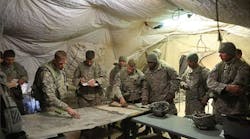TSA Begins Second Phase of Rail-Security Experiment
Amtrak passengers boarding long-distance trains at Washington, D.C.'s Union Station had their checked luggage screened for explosives last month as part of the second stage of a pilot program exploring new measures for rail security.
The goal of Transit and Rail Inspection Pilot (TRIP) Phase II is to evaluate the use of emerging technologies in a rail environment to screen checked and unclaimed baggage, as well as temporarily stored personal items and cargo for explosives, Transportation Security Administration (TSA) officials say. "The second phase of the TRIP project will build on the rail-security passenger test and focus on screening of baggage and rail cargo," said Asa Hutchinson, undersecretary for Border and Transportation Security at DHS.
Phase I of TRIP, completed at the end of May, screened passengers and their carry-on baggage for explosives at the Amtrak/MARC rail station at New Carrollton, Md.
TRIP Phase II is expected to yield important data on the effectiveness of screening equipment in a nonclimate-controlled environment as well as the cost and impact on Amtrak operations. This knowledge will aid in prototyping a cargo-screening model that could be applicable to other modes of transportation, TSA officials say.
Hand-held guide to "Most Wanted Terrorists" revised
Officials at Town Compass, LLC, in Seattle last month released the newest edition of its "Most Wanted Terrorists" database for handhelds, including the seven individuals whom FBI Director Robert S. Mueller named recently as the subjects of a "seeking information alert." The update includes suspects' photos and descriptions, organized for easy viewing on hand-held devices.
The free database runs on Town Compass's DataViewer (available in Palm OS, Pocket PC, and Windows Smartphone versions), which enables concise organization and packaging of large volumes of information for display on limited screen sizes. The program can be downloaded from PocketDirectory.com, Handango.com, PalmGear.com, and PocketGear.com. It is a companion to the four-part "Terrorism Survival" bundle created by Town Compass and Stephenson Strategies, a homeland security consulting firm. The package costs $14.95 for a yearly subscription.
"People can have the photos and descriptions at their fingertips at all times in case they spot a suspicious person, easily comparing the person to the photo without endangering themselves," says Town Compass's Bill Andreozzi.
The database also includes the phone numbers of local FBI offices so people who believe they have spotted the suspects can notify authorities immediately (when used on a "smartphone," the database allows one-touch dialing to reach the FBI).
DHS awards of US-VISIT prime contract to Accenture LLP
Officials at the U.S. Department of Homeland Security (DHS) last month named Accenture LLP in Reston, Va., to serve as the prime contractor for US-VISIT to help strengthen security at America's borders and modernize the border-management process.
The prime contractor will provide a wide range of professional services, including strategic support, design, and integration activities; technical solutions; deployment activities; training; and organizational-change management.
The contract covers a base period of five years, with five one-year options. Its value is for a minimum of $10 million and a maximum of $10 billion.
US-VISIT's vision is to deploy end-to-end management and sharing of data with federal officials on foreign nationals and their interactions before they enter, when they enter, while they are in the United States, and when they exit, DHS officials say. This comprehensive view of border management is intended to eventually lead to the creation of a virtual border and will set a course for improved processes to manage and share data on foreign nationals.
Currently, US-VISIT requires that most foreign visitors traveling to the United States on a visa and arriving at an air- or seaport have their two index fingers scanned and a digital photograph taken to verify their identity at the port of entry. By Sept. 30, this process will also apply to visitors traveling under the visa waiver program at all air- and seaports of entry.
Since deploying US-VISIT entry capabilities at 115 airports and 14 seaports on Jan. 5, more than 4.5 million foreign nationals have been processed without adversely affecting wait times, DHS officials claim. For more information, visit www.dhs.gov/us-visit.
DHS launches "Regional Technology Integration" initiative
Officials at the U.S. Department of Homeland Security (DHS) announced last month a new initiative called Regional Technology Integration (RTI) to facilitate the transition of innovative technologies and organizational concepts to regional, state, and local jurisdictions.
Through the program, managed by DHS's Science & Technology directorate, four urban areas across the country have been selected to be the pilot locations. All of the selected regions are currently participating in the Homeland Security Urban Area Security Initiative, and have demonstrated a willingness and capacity to adopt advanced and innovative concepts for emergency preparedness and public safety, DHS officials say.
"This initiative will help communities strengthen their security posture by speeding the introduction and implementation of new technologies," says Homeland Security Under Secretary for Science & Technology Charles McQueary.
These initial locations will provide the science and technology community with a realistic environment to test maturing hardware and concepts. The program will also provide information on how best to choose, deploy, and manage these technologies to strengthen a community's security posture, DHS officials say.
The goal of Homeland Security's Regional Technology Integration initiative is to speed the successful transfer and integration of existing and advanced homeland-security technology systems to local governments in order to improve their preparedness and response.
RAE Systems awarded patent for photoionization detection
Officials at RAE Systems in Sunnyvale, Calif., announced that the company has been awarded U.S. patent 6,734,435 for pioneering photoionization-detection (PID) improvements based on the work of Hong T. Sun and Peter C. Hsi.
PIDs are used to detect levels of toxic, volatile organic compounds (VOCs). VOCs are byproducts of oil refining, plastics manufacturing, and chemical processing.
PIDs work by using UV light to ionize the gas, RAE Systems officials say. Users of conventional PIDs must regularly clean a layer of contamination from the PID's optical window. This PID development enables continuous operation and self-cleaning of PID lamps, and requires little calibration.
"Photoionization detection is the most powerful method to detect the hundreds of volatile organic chemicals that present a daily threat in hazardous situations," says Robert I. Chen, chief executive officer.
This technology will be available in the recently announced EntryRAE, a five-gas detector for confined space entry that includes the patented VOC sensor as well as sensors for breathable oxygen level (O2), carbon monoxide (CO), hydrogen sulfide (H2S), and lower explosive limit (LEL).
RAE Systems is a developer and manufacturer of rapidly deployable, multisensor chemical- and radiation-detection monitors and networks for homeland security and industrial applications.
For more information, go to www.raesystems.com.


